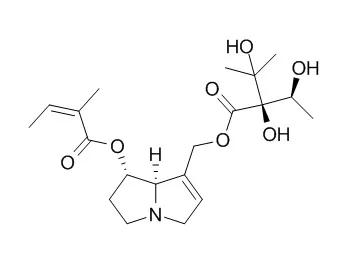| In vitro: |
| Journal of Chemical Ecology February 1997, Volume 23, Issue 2, pp 399-416 | | Allelochemical Activities of Pyrrolizidine Alkaloids: Interactions with Neuroreceptors and Acetylcholine Related Enzymes[Reference: WebLink] |
METHODS AND RESULTS:
Thirteen pyrrolizidine alkaloids (PAs) 3′-acetylHeliosupine, echihumiline, echihumiline N-oxide, echimidine, Heliosupine, Heliosupine N-oxide, heliotrine, monocrotaline, pycnanthine, retronecine, riddeline, senecionine, and seneciphylline) were analyzed for their interactions with acetylcholine-related enzymes, such as acetylcholine esterase (AChE), butyrylcholinesterase (BChE), choline acetyl transferase (ChAT), and neuroreceptors, such as α1- and α2-adrenergic, nicotinergic (nACh), muscarinergic (mACh) and serotonin2 (5-HT2) receptors. Whereas most PAs did not affect the enzymes, they show significant binding activities to mACh and 5-HT2 receptors: Twelve PAs exhibited a 50% inhibition of the specific binding of the radioligand [3H]quinuclidinyl benzilate (QNB) at the mAChR, i.e., IC50 values were between 8.7 μM and 512.5 μM, and 10 PAs exerted a 50% inhibition of the specific binding of the radioligand [3H]ketanserine at the 5-HT2R with IC50 values between 23.2 μM and 608.6 μM. The most active compound was 3′-acetylHeliosupine, which was able to bind to all of the studied receptors with IC50 values in the range between 2.9 μM and 159.7 μM.
CONCLUSIONS:
The data imply that free PAs and PA N-oxides can affect several molecular targets: Besides long-term toxicity through DNA alkylation (by PA metabolites generated in the liver), liver and pneumotoxicity, neuroreceptors (among other molecular targets) may be modulated. The interference of PAs with neuronal signal transduction could mediate adverse physiological responses in herbivores and could thus contribute to chemical defense in plants and animals against herbivores and predators. | | J. Chem. Ecol., 1995, 21(5):507-23. | | Phytotoxic and antimicrobial activity of 5,7-dihydroxychromone from peanut shells[Pubmed: 24234013 ] |
METHODS AND RESULTS:
A flavonoid decomposition product that is present in peanut (Arachis hypogaea) shells, 5,7-dihydroxychromone (DHC), was found to inhibit the radial growth of cultures of the soil pathogenic fungiRhizoctonia solani andSclerotium rolfsii with I50 (the concentrations of DHC required to inhibit growth 50%) values of 18 and 26μM, respectively. Radicle elongation of velvetleaf, corn, peanut, and wheat was inhibited by DHC with I50 values of 30, 50, 65 and 200μM, respectively. DHC had no effect on the growth ofBradyrhizobium sp. at 10μM in medium containing low (1.0 g/liter) mannitol as the carbon source, although the related flavones luteolin and chrysin each promoted bacterial growth at 10μM 48 hr after inoculation. When tested in high (10.0 g/liter) mannitol medium, DHC initially inhibited growth ofBradyrhizobium sp., but 120 hr after inoculation the growth of all treatments were similar.
CONCLUSIONS:
These results suggest a role for DHC released from peanut shells in suppressing pathogenic fungal infection and competing plant growth but not forBradyrhizobium growth promotion. |
|






 Cell. 2018 Jan 11;172(1-2):249-261.e12. doi: 10.1016/j.cell.2017.12.019.IF=36.216(2019)
Cell. 2018 Jan 11;172(1-2):249-261.e12. doi: 10.1016/j.cell.2017.12.019.IF=36.216(2019) Cell Metab. 2020 Mar 3;31(3):534-548.e5. doi: 10.1016/j.cmet.2020.01.002.IF=22.415(2019)
Cell Metab. 2020 Mar 3;31(3):534-548.e5. doi: 10.1016/j.cmet.2020.01.002.IF=22.415(2019) Mol Cell. 2017 Nov 16;68(4):673-685.e6. doi: 10.1016/j.molcel.2017.10.022.IF=14.548(2019)
Mol Cell. 2017 Nov 16;68(4):673-685.e6. doi: 10.1016/j.molcel.2017.10.022.IF=14.548(2019)